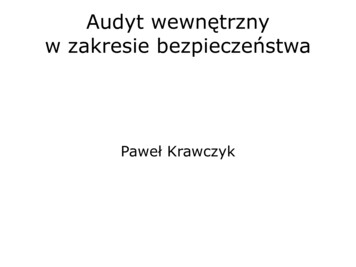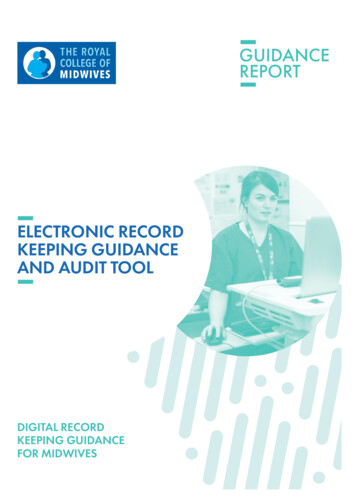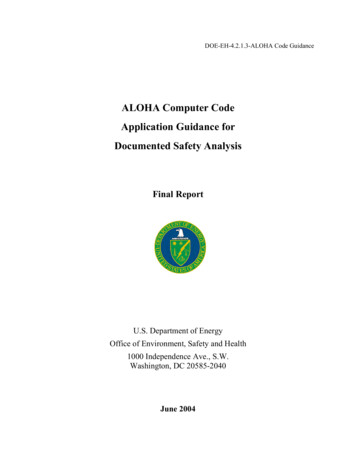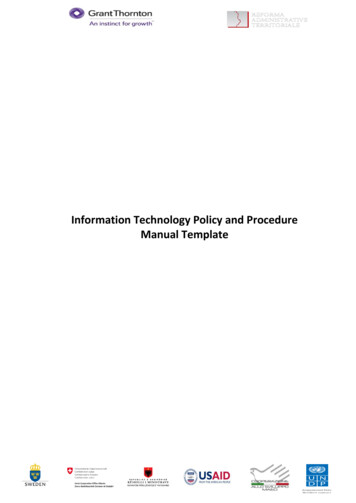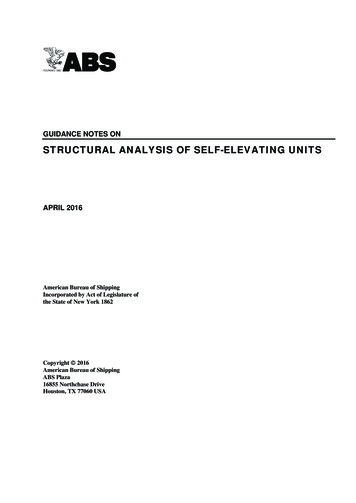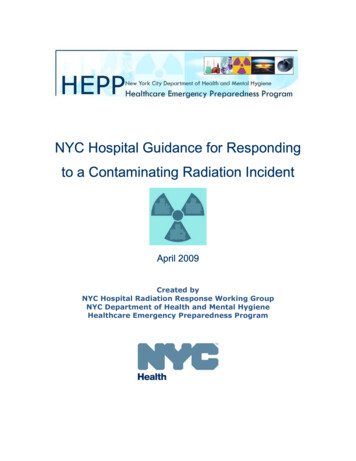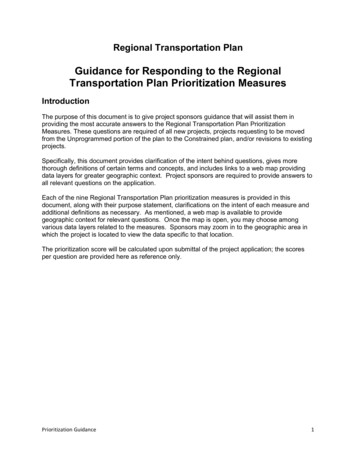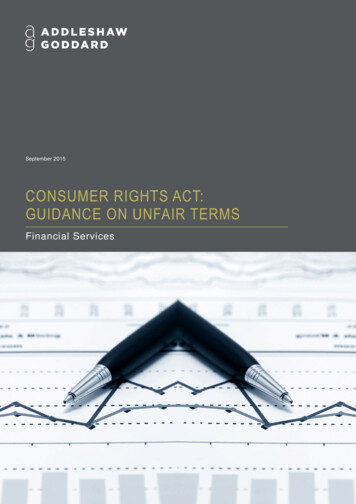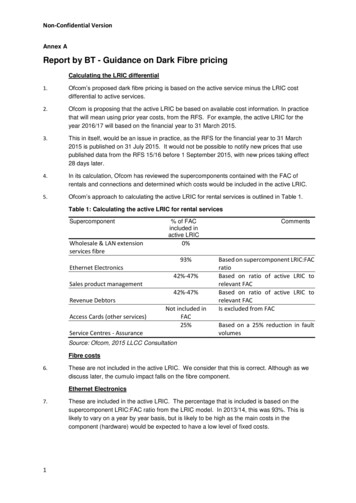
Transcription
Non-Confidential VersionAnnex AReport by BT - Guidance on Dark Fibre pricingCalculating the LRIC differential1.Ofcom’s proposed dark fibre pricing is based on the active service minus the LRIC costdifferential to active services.2.Ofcom is proposing that the active LRIC be based on available cost information. In practicethat will mean using prior year costs, from the RFS. For example, the active LRIC for theyear 2016/17 will based on the financial year to 31 March 2015.3.This in itself, would be an issue in practice, as the RFS for the financial year to 31 March2015 is published on 31 July 2015. It would not be possible to notify new prices that usepublished data from the RFS 15/16 before 1 September 2015, with new prices taking effect28 days later.4.In its calculation, Ofcom has reviewed the supercomponents contained with the FAC ofrentals and connections and determined which costs would be included in the active LRIC.5.Ofcom’s approach to calculating the active LRIC for rental services is outlined in Table 1.Table 1: Calculating the active LRIC for rental servicesSupercomponent% of FACincluded inactive LRICWholesale & LAN extensionservices fibre0%93%Ethernet Electronics42%-47%Sales product management42%-47%Revenue DebtorsAccess Cards (other services)CommentsNot included inFAC25%Service Centres - AssuranceBased on supercomponent LRIC:FACratioBased on ratio of active LRIC torelevant FACBased on ratio of active LRIC torelevant FACIs excluded from FACBased on a 25% reduction in faultvolumesSource: Ofcom, 2015 LLCC ConsultationFibre costs6.These are not included in the active LRIC. We consider that this is correct. Although as wediscuss later, the cumulo impact falls on the fibre component.Ethernet Electronics7.1These are included in the active LRIC. The percentage that is included is based on thesupercomponent LRIC:FAC ratio from the LRIC model. In 2013/14, this was 93%. This islikely to vary on a year by year basis, but is likely to be high as the main costs in thecomponent (hardware) would be expected to have a low level of fixed costs.
Non-Confidential VersionOfcom’s active LRIC calculation is based on the FAC reported in the RFS. However, in itscalculation of FAC for the purpose of the Charge control, Ofcom excludes around 5% of thecosts of Ethernet Electronics in the RFS to reflect BT’s changes in how it historicallyrecovered the upfront costs of the electronics.1 The active LRIC calculation should reflectthis reduction in the FAC which would reduce the active LRIC by around .8.Sales Product Management (SPM)9.The sales & product management FAC varies between 19 and 40 per circuit. There is anear linear relation between the FAC of SPM and the FAC of the rest of the components foreach service. This suggests that SPM costs are allocated proportionately to previouslyallocated costs, rather than in relation to any specific cost driver. A dark fibre service wouldhave a lower FAC than the active service (because it would have no electronics), thusleading to a lower SPM cost allocation.10.Ofcom’s approach to calculating the active LRIC for SPM is unclear.11.Ofcom takes the SPM FAC for each service (e.g. 22.31 for LA non-WECLA). It then“allocates[s] share to active service using share of active incremental costs relative to EADcost stack”.12.It is not entirely clear what this means. Ofcom claims the calculation is based on: “theproportion of the overall EAD cost stack which related to the active LRIC”2. There are twointerpretations of this: Approach one: Take all supercomponents other than SPM and revenue debtors andtake the FAC. Then calculate the active LRIC of all supercomponents other thanSPM/revenue debtors. Dividing the second number (LRIC) by the first number (FAC)gives the active LRIC:FAC ratio to be used. This would be around for standardservices, and for LA services. Approach two: Take the FAC of each service. Then calculate the active LRIC of allsupercomponents other than SPM/revenue debtors. Dividing the second number(LRIC) by the first number (FAC) gives the active LRIC:FAC ratio to be used. Thiswould be around for standard services, and for LA services.13.Both approaches lead to counterintuitive results for two reasons.14.Firstly, the total LRIC:FAC ratio for active LA services is higher than active standardservices. This is because the LA services use less fibre (and hence have a lower FAC), butthe LRICs for the active LA and standard services are fairly similar. On this basis the activeLRIC of SPM is lower for standard services than LA services, despite the FAC of SPM beinghigher. It would not seem ‘reasonable’ to charge differential prices for standard and LAactive services based on an assumption that they would have different SPM costs.1222015 LLCC, paragraph A7.48-A7.522015 LLCC, paragraph 8.51
Non-Confidential Version15.Secondly, it is not clear that Ofcom’s assumption that any significant portion of costs isrelated to sourcing equipment. The two largest cost categories in the component consist of“Plant Support, Core Transmission Equipment” and “Transfer Charges, Plant Support”. It isnot clear that these cost categories would be reduced substantially if BT supplied dark fibreinstead of an active service. If there is any reduction in costs related to not sourcingequipment it is unlikely to be related to the relationship between the active LRIC and FAC ofthe other components. We would therefore suggest that there should not be a reduction inSPM costs due to avoided equipment costs.16.This proposal would reduce the active LRIC differential by around .Revenue Debtors17.Ofcom takes the same approach with revenue debtors as it does with SPM, leading to thesame issues. In practice, revenue debtors is almost entirely related to the price. The ratioof revenue debtor cost to price is around . Ofcom should therefore take of the activeLRIC differential (excluding revenue debtors) to calculate the active LRIC differential ofrevenue debtors.18.This would reduce the active LRIC by around .Service Centres – Assurance19.Ofcom has assumed that 25% of faults would be avoided if BT supplied a dark fibre circuitinstead of an EAD 1Gbit/s service. Ofcom bases this on data from BT that showed that 2122% of faults were equipment related.3 Ofcom also notes that around 50% of all faults weremarked as “fault not found” or “right when tested”, and that this data therefore provides littleinformation on the reduction in faults that might be expected if BT provided dark fibreinstead of active circuits.20.We would make a number of points:33 It is unclear why Ofcom has increased the % of faults avoided from 21-22% up to25%. On a dark fibre circuit, it is the dark fibre purchaser who will monitor for faults. Anyequipment related faults should be picked up by the dark fibre purchaser and thenrectified. However, there are likely to be cases where the dark fibre purchaser cannotidentify a fault on their equipment, and so passes the fault issue back to Openreachalthough the ultimate fault lies with the dark fibre purchaser. Even if 21% of all faultsrelate to equipment, it is unclear that this would lead to a 21% reduction in the volumeof work for the assurance centre, because Openreach would incur costs relating tohandling equipment related to faults incorrectly reported to it. The LRIC:FAC ratio of the assurance centre cost category is . Therefore areduction in fault volumes of 21% would not lead to a 21% reduction in costs, butaround an reduction in costs.2015 LLCC, paragraph 8.47
Non-Confidential Version21.Ofcom should: Take only of the FAC of the assurance costs. This would reduce the active LRICby around . Reflect in its assumptions the fact that BT’s assurance centres will have to deal withincorrectly reported equipment faults.Cumulo22.Ofcom has proposed that because dark fibre would be “lit” by the purchaser, that BT wouldsave cumulo rates on the dark fibre.23.The total cumulo allocated due the WES fibre supercomponent in the AI market was around (based on the new 2014/15 allocation methodology). This is around of the total WESfibre that relates to AI services. Around of capital of the WES fibre supercomponentrelated to fibre (the rest is mostly duct). We therefore take costs out of the WES fibresupercomponent.24.This calculation is based on high level data, further data is being supplied to us, and we mayrevise this allocation.25.We have assumed that there is no cumulo effect on any other supercomponent.26.There is also likely to be a small effect on main link because there will be less “lit” fibre in themain link. This effect is likely to be less than per km.BT estimate of active LRIC differential in 13/1427.Table 2 outlines our estimate of the active LRIC and FAC of rental services using Ofcom’sproposed methodology, based on the 2013/14 RFS and LRIC model. We have excludedAccess Cards, because Ofcom will not include these costs in the cost stack and we will nolonger include them in the cost stack from 2014/15 onwards.Table 2: Estimation of the active LRIC and FAC for EAD 1Gbit/s services based onOfcom methodologyLocal AccessStandardFACActiveLRICFACActiveLRICWholesale & LAN extension servicesfibre etc 856.86 2,272.76Ethernet ElectronicsSales product managementService Centres - AssuranceRevenue DebtorsTotal 902.67 22.31 63.83 24.45 1,870.12 Supercomponent 902.67 34.37 63.83 37.69 3,311.32Source: BT RFS, LRIC Model and own analysis28.4Table 3 sets out our estimate of the active LRIC and FAC for EAD 1Gbit/s services basedon Ofcom’s methodology but revised as per the above analysis.
Non-Confidential VersionTable 3: Estimate of the active LRIC and FAC for EAD 1Gb/s services using therevised methodologyLocal AccessSupercomponentWholesale & LAN extension servicesfibre etcEthernet ElectronicsSales product managementService Centres - AssuranceRevenue DebtorsTotal29.FACActiveLRIC 856.86 902.67 19.29 63.83 21.15 1,863.80StandardFACActiveLRIC 2,272.76 902.67 34.37 63.83 37.69 3,311.32Table 4 compares our estimates of the active LRIC using Ofcom’s methodology and ourrevised methodology based on Ofcom’s approach.Table 4: Comparison of the LRIC differential between Ofcom’s approach and therevised methodologyLocal Access30.5SupercomponentOfcomWholesale & LAN extension servicesfibre etcEthernet ElectronicsSales product managementService Centres - AssuranceRevenue DebtorsTotal 15.00 839.48 10.47 15.96 11.47 892.76Revisedapproach StandardOfcom 39.77 839.48 9.08 15.96 9.95 915.13Revisedapproach We consider that Ofcom’s approach to calculating the active LRIC differential is flawed, andthat the alternative approach is preferable:
Non-Confidential Version On 2013/14 data using Ofcom’s approach, the active LRIC differential is 3 higher forLocal Access than Standard variants. This is because of the flawed methodology forSPM and for Revenue Debtors. On 2013/14 data, based on the revised approach the active LRIC for both LocalAccess and Standard variants is around 20 lower than under Ofcom’s approach.The SPM LRIC is very low (as SPM costs are almost entirely fixed), and the revenuedebtors LRIC is much lower.Forecasting the LRIC differential to 2018/1931.In order to forecast the active LRIC to 2018/19, we have taken our 2013/14 estimates usingOfcom’s methodology and our proposed methodology and applied Ofcom’s forecastefficiency estimates from 2013/14 to 2018/19. We have applied Ofcom’s efficiencyassumption to opex of 4.5% in 2014/15 and 2015/16 (as per the 2015 BCMR) and 5% in2016/17 to 2018/19 (as per Ofcom’s current proposal). We have only applied this to opexcosts.Table 5: Estimate of LRIC differential 2013/14, based on Ofcom’s methodologyYearDF 017/182018/19 893 858 825 790 756 723 913 878 844 807 773 739OFCOM 2018/19 753 790Table 6: Estimate of active LRIC differential – Using revised 8/19OFCOM 2018/19DF LocalAccessDFStandard 753 79032.Using the Ofcom approach, we estimate that the active LRIC differential will fall to around per circuit, whereas Ofcom’s initial estimate is around 750- 790 per circuit. Given thatwe have only applied a crude estimate to the efficiency calculation, we consider that ourestimate is likely to be reasonable.33.Using our revised methodology, the active LRIC differential falls to around .6
Report by BT - Guidance on Dark Fibre pricing Calculating the LRIC differential 1. Ofcom's proposed dark fibre pricing is based on the active service minus the LRIC cost differential to active services. 2. Ofcom is proposing that the active LRIC be based on available cost information. In practice that will mean using prior year costs, from .

